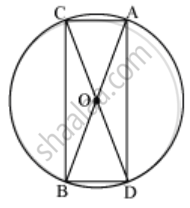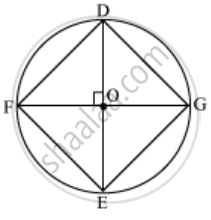Advertisements
Advertisements
Question
Draw a circle and any two of its diameters. If you join the ends of these diameters, what is the figure obtained? What figure is obtained if the diameters are perpendicular to each other? How do you check your answer?
Solution
A circle can be drawn of any convenient radius, also having its centre as O. Let AB and CD be two diameters of this circle. When we join the ends of these diameters, a quadrilateral ACBD is formed.

As we know that the diameters of a circle are equal in length, therefore, the quadrilateral so formed will have its diagonals of equal length.
Also, OA = OB = OC = OD = radius r and if a quadrilateral has its diagonals of same length which are bisecting each other, then it will be a rectangle.
Let DE and FG be two diameters of this circle such that these are perpendicular to each other. A quadrilateral is formed by joining the ends of these diameters.

Here, OD = OE = OF = OG = radius r
In this quadrilateral DFEG, the diagonals are equal and perpendicular to each other. Also, since these are bisecting each other, it will be a square.
The length of the sides of the quadrilateral so formed can be measured to check our answers.
APPEARS IN
RELATED QUESTIONS
Draw circle for the following measurements of radius(r)/diameters(d)
r = 4 cm
Draw circle for the following measurements of radius(r)/diameters(d)
d = 12 cm
Draw circle for the following measurements of radius(r)/diameters(d)
r = 3.5 cm
Draw circle for the following measurements of radius(r)/diameters(d)
r = 6.5 cm
Draw circle for the following measurements of radius(r)/diameters(d)
d = 6 cm
With a given centre and a given radius, only one circle can be drawn.
Draw a circle of radius 6 cm using ruler and compasses. Draw one of its diameters. Draw the perpendicular bisector of this diameter. Does this perpendicular bisector contain another diameter of the circle?
With the same centre O, draw two circles of radii 4 cm and 2.5 cm.
Let A, B be the centres of two circles of equal radii; draw them so that each one of them passes through the centre of the other. Let them intersect at C and D. Examine whether `overline("AB")` and `overline"CD"` are at right angles.
